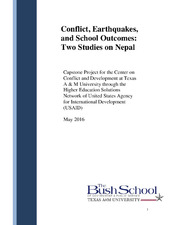| dc.description.abstract | The increased frequency of natural disasters globally has prioritized the need for a
broader understanding of disaster resilience. More recently, on April 25 and May 12 of
2015, two major earthquakes devastated many Nepalese communities, inflicting damage
on multiple sectors of the society. Given the enormous amount of damage caused by the
earthquakes, this natural disaster is the greatest natural disaster tragedy to hit Nepal in
over 80 years. Almost ten years before the earthquakes shook Nepal, ten years of
destructive armed conflict came to a end. This study will examine the link between these
two events, both conceptually and empirically, by addressing the question: Did conflict
experience during the armed conflict in Nepal impact the degree of damage resulting
from the 2015 earthquakes? | en |


